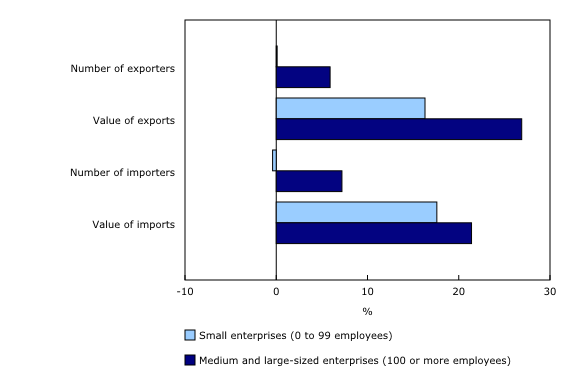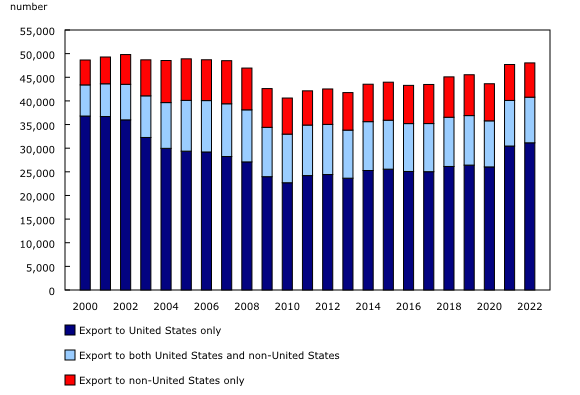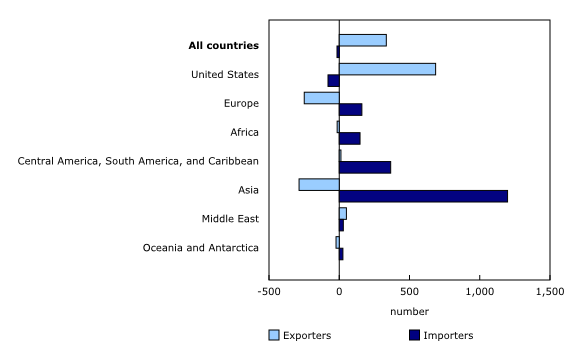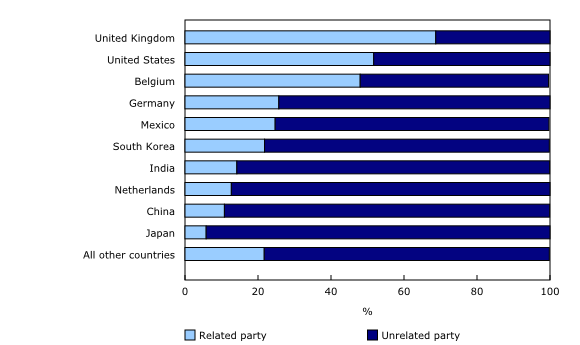Trade by exporter and importer characteristics: Goods, 2022
Released: 2023-05-18
Both the value of exports and imports of goods rose substantially in 2022. However, the rise in the value of trade was not reflected in the number of traders. The number of exporting enterprises (+0.7%) edged up to reach 48,036 in 2022, while the number of importing enterprises remained stable at 160,238.
Most of the growth in merchandise trade value in 2022 was attributed to medium- and large-sized enterprises, defined as those with 100 or more employees. The number of these exporting and importing enterprises went up by 5.9% and 7.2%, respectively.
Small enterprises, which comprised the lion's share (94.6%) of all traders in 2022, did not experience a similar rise in the number of traders year over year. The number of small-sized exporters was relatively unchanged, while the number of small-sized importers went down slightly, concentrated among those with one to nine employees (-4.0%).
Number of Canadian exporters to the United States reaches 20-year high
Overall, the number of exporters to the United States rose by 686 to reach 40,787 in 2022, the highest level since 2003.
In contrast, the number of exporters to Asia and Europe both declined for a third consecutive year in 2022, with the decrease concentrated among small exporters. The number of exporters to the Russian Federation (-558) and Ukraine (-143) declined, against the backdrop of the conflict between the two countries. Meanwhile, the number of exporters to China (-298) and Hong Kong (-160) also went down, as public health measures impacted their local economics.
Among importers, the trend was reversed. The number of enterprises importing goods from the United States (-80) edged down in 2022, while those importing goods from Asia (+1,198) showed an increase, led by Vietnam and India. The number of enterprises importing from Europe (+161) edged up, although the increase was moderated by a large decline in the number of enterprises importing from the Russian Federation (-487).
Related party trade makes up more than two-fifths of Canada's international merchandise trade value
Related party trade, also known as intra-firm trade, is a common global goods production and distribution arrangement between a parent corporation and its affiliate in another country.
One-quarter of Canadian exporting enterprises traded with a related party in 2022, while less than 1 in 10 importing enterprises did so. By value, related party transactions had an outsized impact on Canada's international merchandise trade, totalling $611.4 billion in 2022 and representing significant shares of the value of both exports (45.1%) and imports (41.4%).
Related party trade varied between regions. In 2022, a smaller share of exporters to the United States traded with a related party (21.7%) than did exporters to non-US destinations (31.3%). However, by value, more than half of all goods exports to the United States were sold to a related party, as opposed to less than a quarter of non-US exports.
Among non-US countries, the related party share of export value varied depending on the country of destination and industry involved. More than two-thirds of the value of exports to the United Kingdom was between related parties, primarily tied to primary metal manufacturing. Conversely, the related party share of exports to major trading partners in Asia, such as India (14.2%), China (10.8%) and Japan (5.8%), tended to be much lower.
Note to readers
The Trade by Exporter Characteristics: Goods and Trade by Importer Characteristics: Goods programs are an initiative at Statistics Canada undertaken to analyze the business characteristics of exporters and importers in Canada. These estimates are formed by linking customs trade data records to business entities in Statistics Canada's Business Register.
Data on exports to the United States are collected by the US Census Bureau and transmitted to Statistics Canada as part of the Canada–US data exchange, while data on exports to the rest of the world are collected jointly by Statistics Canada and the Canada Border Services Agency.
Customs import data are collected jointly by Statistics Canada and the Canada Border Services Agency.
The Business Register contains the complete operating and legal structure of enterprises operating in Canada, as well as their key characteristics, such as employment, and North American Industry Classification System code.
Survey definitions
This release contains information at both the enterprise and establishment levels. An enterprise is defined as the statistical unit that directs and controls the allocation of resources relating to its domestic operations, and for which consolidated financial statements are maintained. An establishment is the smallest statistical unit within an enterprise structure and better reflects the primary industrial activity and the province of the exporter and importer. The two measures generate a different number of exporting and importing units, as well as a different industry allocation of these units.
Small enterprises have fewer than 100 employees, including those that did not report any employment. Medium-sized enterprises have 100 to 499 employees, while large enterprises have 500 or more employees.
Country of origin is the country of production or the country in which the final stage of production or manufacture occurs.
For exports, a related party is defined as a party who holds or controls ten percent or more of the outstanding voting stock or share of the other party it is transacting with. For imports, the threshold is five percent.
In this release, data disseminated at the provincial level are conceptually different from customs-based merchandise export and import data. Provincial data for the Trade by Exporter Characteristics: Goods and Trade by Importer Characteristics: Goods programs are based on the province where the exporter and the importer are located. Goods can be shipped to other provinces for final consumption or can be shipped from other provinces when leaving Canada. Customs-based merchandise imports are based on the province of clearance: this is the province where the goods are cleared at customs, but this may not always be the province in which the importer is located. Customs-based merchandise exports are based on the province of origin: this is the province where the goods are grown, produced, extracted or manufactured.
Detailed information on concepts and methodology relating to this release is available on the Trade by Exporter Characteristics: Goods survey page and the Trade by Importer Characteristics: Goods survey page.
Survey coverage
In this release, the total value of exports and imports refers to the part of the annual domestic export and import value (customs basis) that can be linked to specific entities in the Business Register each year. Annual domestic export and import values (customs basis) can be obtained from the Canadian International Merchandise Trade Web Application and Table 12-10-0119-01. Additional information and definitions related to domestic merchandise exports and imports are available on the survey page for Canadian International Merchandise Trade (Customs Basis).
Export data are available for the reference period of 2000 to 2022, while import data are available for the reference period of 2005 to 2022. For each reference year, the identified exporting and importing enterprises accounted for at least 96% of the total domestic export and import value. Throughout this release, the percentage share of export sales and import purchases corresponds to the share of the annual domestic export and import value for which there was an identified exporter and importer. The number of exporters and importers corresponds to the number of exporters and importers identified within the Business Register by the Trade by Exporter Characteristics: Goods and Trade by Importer Characteristics: Goods programs.
Products
The data visualization product "Trade in Goods by Exporter and Importer Characteristics: Interactive Tool," which is part of Statistics Canada – Data Visualization Products (71-607-X), is now available.
The updated Canada and the World Statistics Hub (13-609-X) is available online. This product illustrates the nature and extent of Canada's economic and financial relationship with the world using interactive graphs and tables. This product provides easy access to information on trade, investment, employment and travel between Canada and a number of countries, including the United States, the United Kingdom, Mexico, China and Japan.
The Methodological Guide: Canadian System of Macroeconomic Accounts (13-607-X) is available.
The User Guide: Canadian System of Macroeconomic Accounts (13-606-G) is also available. This publication will be regularly updated to maintain its relevance.
Contact information
For more information, or to enquire about the concepts, methods or data quality of this release, contact us (toll-free 1-800-263-1136; 514-283-8300; infostats@statcan.gc.ca) or Media Relations (statcan.mediahotline-ligneinfomedias.statcan@statcan.gc.ca).
- Date modified:






